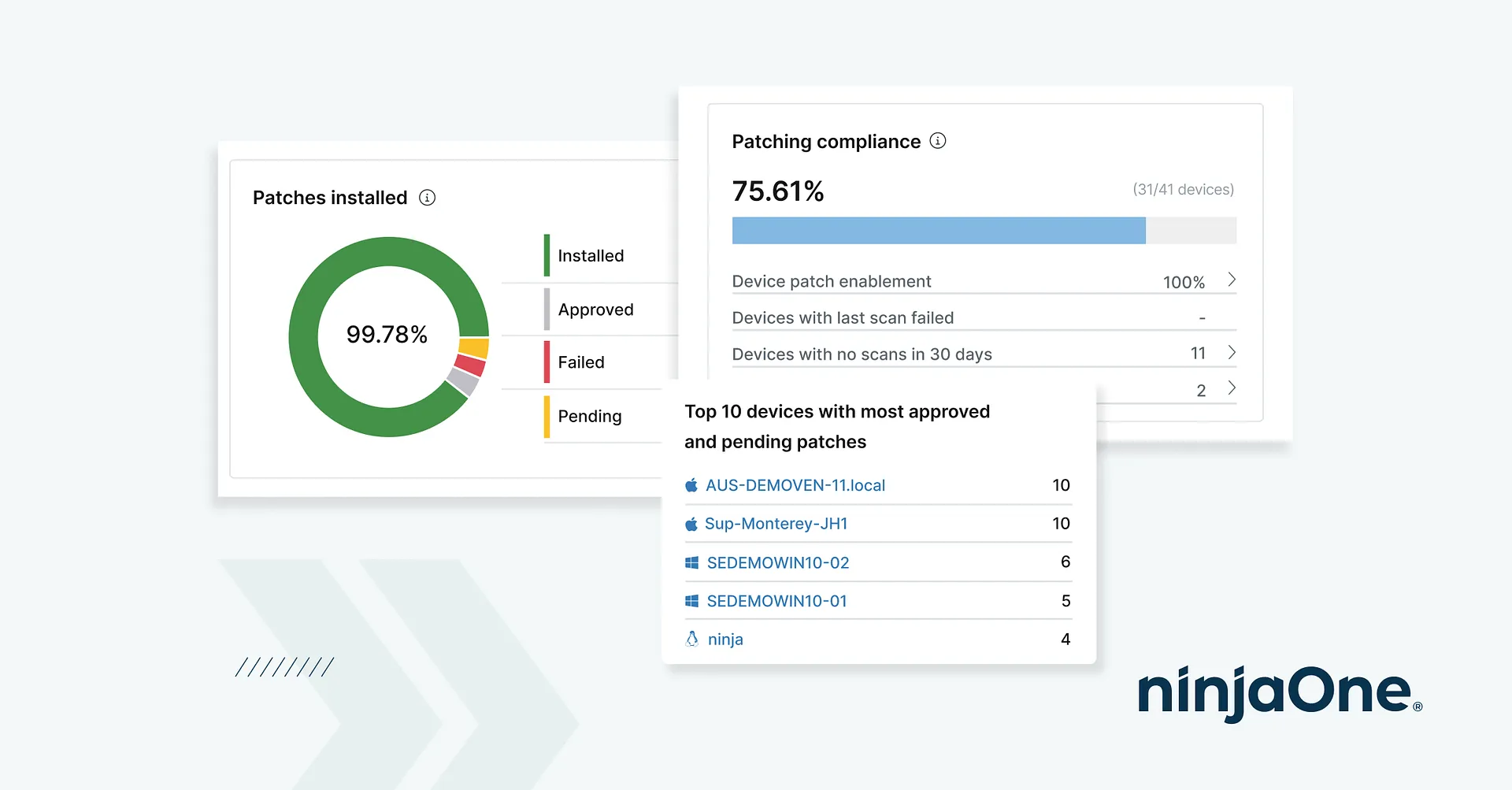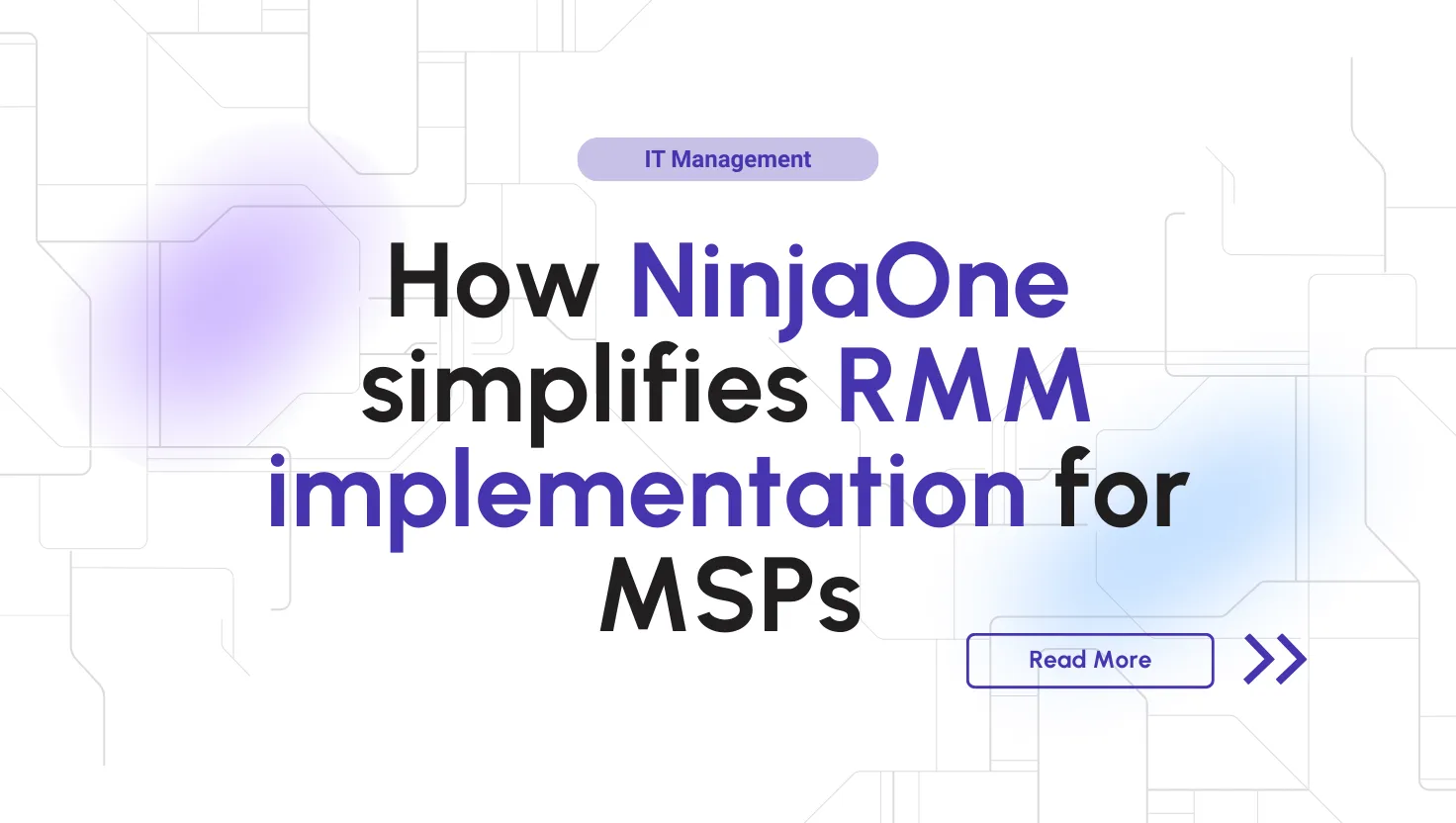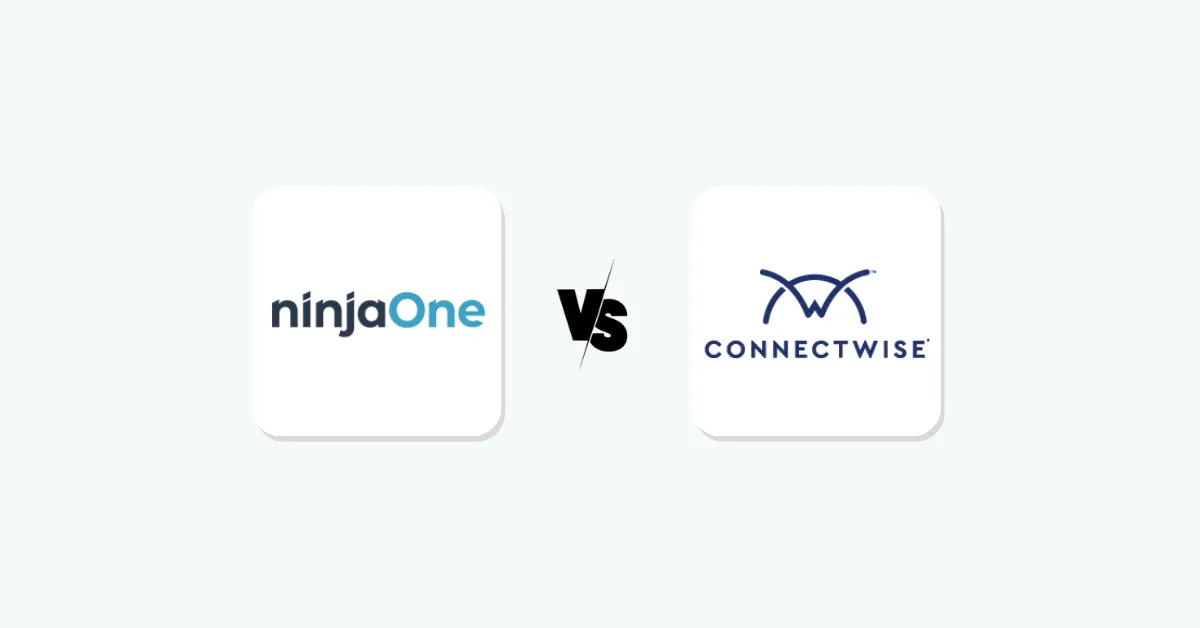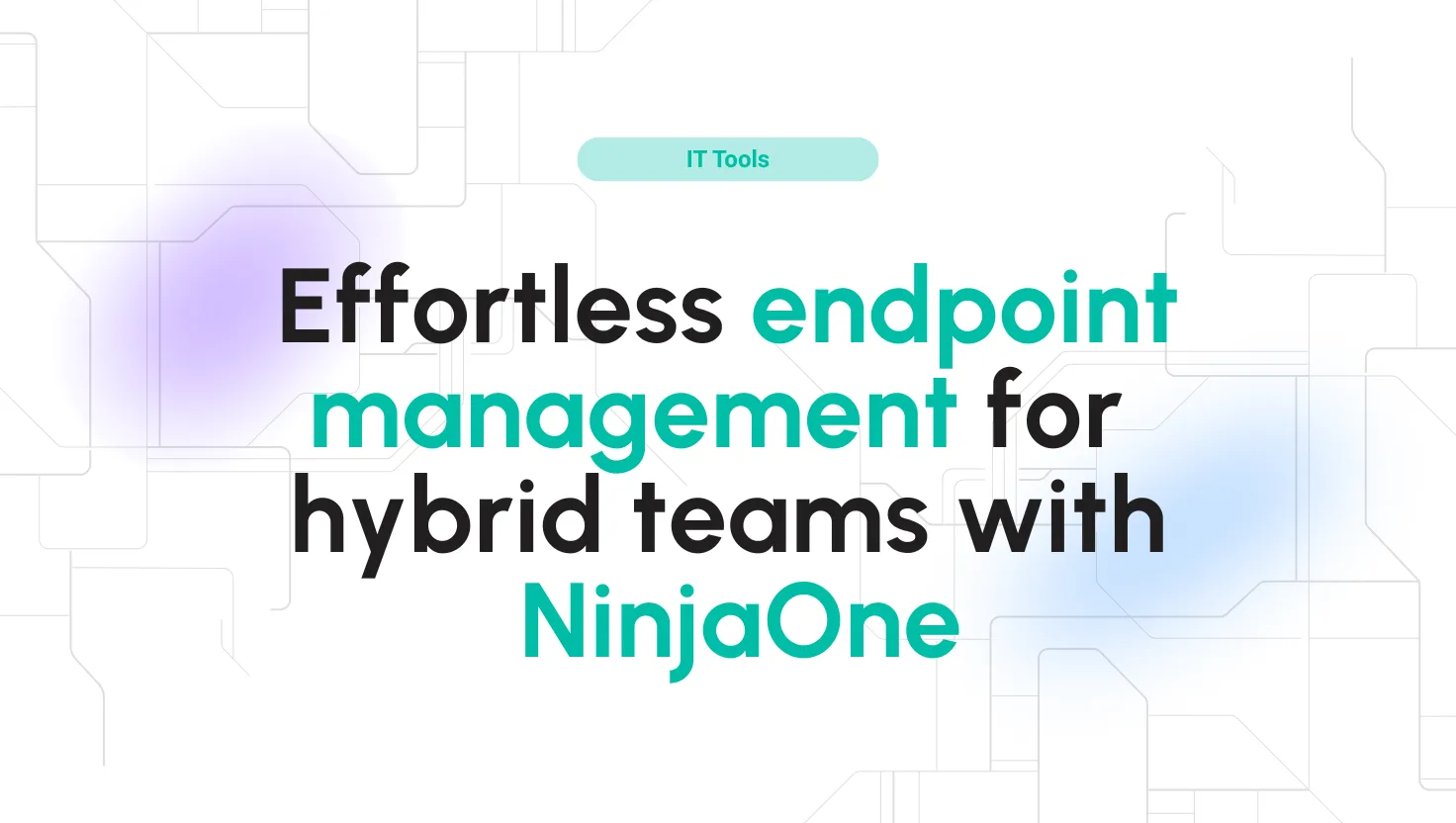Implementing a Remote Monitoring and Management (RMM) solution is a critical project for any managed service provider (MSP) looking to streamline operations and deliver high-quality IT services.
A well-structured implementation ensures you get quick value from your RMM, minimize disruptions, and set your team up for long-term success.
From initial planning and platform selection to deployment, automation, and scaling – all while highlighting how an intuitive, unified platform like NinjaOne can make each step easier and more effective.
Define your objectives and requirements
Start by clearly outlining what you want to achieve with a new RMM platform. Are you aiming to improve response times, automate routine maintenance, support more endpoints, or all of the above?
Defining success metrics (e.g., reducing onsite visits by 50% or cutting patching time in half) will help guide your implementation. Consider your clients’ needs and the services you provide – this ensures the RMM configuration will cover all critical monitoring, security, and support tasks.
Key planning tasks:- Inventory your environment: Document the number of endpoints, device types (Windows, Mac, Linux, mobile, etc.), and software applications you’ll manage. This influences licensing and deployment strategies.
- Identify priority use cases: List the most important tasks your RMM must handle (e.g. 24/7 uptime monitoring, automated patching, remote support for users). This will inform which RMM features to focus on during setup.
- Set a timeline and budget: Determine when you need the RMM fully operational and how much you can invest in tools and labor. Having a timeline helps you leverage rapid deployment options for quick time-to-value.
For example, many MSPs choose NinjaOne because its cloud-native design allows for very fast onboarding and minimal upfront infrastructure.
Transform your MSP operations. Experience NinjaOne risk-free!
By knowing your goals and constraints upfront, you can make smarter decisions in the next steps and measure the project’s success. Keep these requirements on hand as you evaluate RMM solutions and plan the rollout.
Choose your unified RMM platform
Selecting the right RMM software is arguably the most important decision in this process. You’ll want a platform that not only checks all the technical boxes (monitoring, alerting, remote access, patch management, etc.) but is also easy to use, quick to deploy, and aligned with your MSP’s growth plans.
An intuitive, unified platform will greatly simplify implementation and daily operations.
Factors to consider when evaluating RMM platforms:-
Ease of use
An RMM with a simple, intuitive interface shortens the learning curve for your technicians and reduces errors. Look for modern, well-designed dashboards and clear workflows.
For instance, NinjaOne is widely praised for its easy-to-navigate dashboard and smooth user experience, making it accessible for techs of all skill levels.

-
Rapid deployment
Time-to-value is crucial. Cloud-based RMMs can often be rolled out faster than on-premises solutions since there’s no server setup – you just deploy agents to endpoints.
NinjaOne, for example, is a cloud-native RMM that can be up and running quickly, thanks to its lightweight agent and streamlined onboarding process.
Many MSPs choose NinjaOne because its fast deployment and onboarding allow them to start managing clients’ devices in days rather than weeks.
-
Unified feature set
The best RMM solutions bundle multiple IT management tools into one platform. This could include remote control for support, patch management, scripting, antivirus integrations, backup, and even documentation or ticketing.
A unified platform means you won’t need to juggle separate tools for core tasks. NinjaOne makes it easy to have everything in one place – it combines remote monitoring, automated patching, scripting, and endpoint management in a single pane of glass.
It even offers built-in remote support capabilities and an IT documentation module, so technicians can troubleshoot and reference client information without switching apps.
-
Automation capabilities
Automation is key to operating efficiently at scale. Evaluate how the RMM handles automated tasks like patch deployment, software updates, self-healing scripts, and scheduled maintenance.
Does it have a robust scripting engine or a library of pre-built automations? NinjaOne is known for its strong automation features that help MSPs reduce manual workloads (it’s consistently rated #1 by users for automation and remote support capabilities).

-
Scalability and performance
Consider whether the platform can grow with your business. Can it handle adding dozens of new clients and hundreds or thousands of endpoints? Cloud-based solutions often scale more easily, since you’re not limited by your own hardware.
NinjaOne’s cloud infrastructure and API-driven architecture are designed to support MSPs from small startups to those managing very large and complex environments.
As your MSP grows, a scalable RMM will accommodate a vast number of endpoints without a drop in performance.
-
Cost structure
Understand the pricing model (per-device, per-technician, tiered bundles, etc.) and ensure it fits your business model. Also, beware of hidden costs – some vendors charge extra for certain modules or even for customer support.
NinjaOne uses transparent per-endpoint pricing and includes all the essential features (and support) without surprise fees.
This means you get patching, remote control, and other key capabilities built in, and you won’t be nickel-and-dimed for training or assistance down the road.
See how NinjaOne fits your budget!
Take the time to demo or trial a few top RMM options. Involve your technicians in the evaluation – since they’ll be the day-to-day users, their feedback on usability is vital.
Ultimately, choosing a platform that is intuitive, comprehensive, and aligned with MSP best practices, like NinjaOne, will set the foundation for a smoother implementation and happier techs.
Plan for rapid deployment and onboarding
With your RMM platform chosen, the next step is deploying it across all the devices and getting your team and clients on board. A detailed deployment plan will help ensure nothing is missed and that you can start realizing benefits quickly.
The goal is a rapid, well-organized rollout that avoids disruption to client services.
Deployment checklist:- Agent installation: Plan how you’ll install the RMM agent (group policy, remote push, email links, or image bundles). Prioritize critical servers first. NinjaOne provides multiple rollout methods and automation to speed this up.
- Batch rollouts: For large environments, deploy in phases (by site or device type). Test small groups before scaling. NinjaOne’s automated provisioning ensures fast, consistent setups across endpoints.
- Onboarding new clients: Use a standard checklist – kickoff call, set expectations, and install agents on day one. Show clients how RMM improves service with proactive monitoring and faster issue resolution.
- Team training: Train technicians during rollout. With an intuitive platform like NinjaOne, most techs adapt quickly. Provide quick guides and use free vendor training resources to accelerate learning.
- Verify connectivity: As agents go live, confirm they appear in the dashboard and report correctly. Troubleshoot any offline devices early to avoid blind spots.
The focus here is speed and consistency. You want to deploy the RMM quickly to start getting value as soon as possible.
Using NinjaOne for rapid deployment and onboarding significantly reduces the time and effort required in this phase, meaning you can fully transition to your new RMM in a matter of days or weeks, not months.
Configure monitoring, alerts, and policies
Once the RMM agents are deployed, it’s time to configure the system to effectively monitor your clients’ environments. Think of this as customizing the RMM to fit the specific needs and standards of your MSP and clientele.
A “set-and-forget” approach doesn’t work here – you should intentionally set up monitoring thresholds, alert rules, and automation policies that align with your service delivery goals.
Key configuration steps:-
Set up device organization
Organize endpoints into logical groups within the RMM console, such as by client, location, or device type. This makes it easier to manage policies and see the status at a glance. Most RMMs allow you to create hierarchies or tags.
-
Define monitoring checks
Establish which health checks and performance metrics the RMM should track on each system. This includes CPU and memory usage, disk space, critical services running, antivirus status, backup status, etc. Leverage any pre-built monitoring templates provided by the RMM for common server roles or devices – these can save time.
-
Configure alerts and thresholds
Determine what conditions should trigger alerts to your team. For example, you might set alerts for server CPU consistently over 90%, or if any workstation goes offline for more than 15 minutes.
Tune the thresholds and avoid overly sensitive settings that could create noise (false alarms). NinjaOne allows flexible alert policies – you can set different alerting rules for critical servers vs. standard PCs, and define escalation paths.
-
Implement patch management policies
In the RMM’s patch management module, create policies for how and when updates are applied. You might have a policy for servers (e.g. critical patches auto-install on weekends with reboot windows) and one for workstations (install updates overnight on weekdays). Include third-party software patching if available.
Automation here is key – NinjaOne, for instance, allows you to automate patch deployment across OSes and apps with fine-grained scheduling.

-
Security settings
Ensure the RMM is configured securely. This includes enabling two-factor authentication for your technicians’ RMM accounts, applying role-based access so techs only see the clients they manage, and verifying that the agent-to-server communication is encrypted.
-
IT documentation integration
This is a step some MSPs overlook during RMM setup. If your RMM has an IT documentation module or integrates with documentation platforms, now is the time to link it.
NinjaOne includes a documentation add-on that allows you to store and view IT documentation in the same interface as your device list, which can greatly speed up troubleshooting.
Automate patching & Routine maintenance
A modern RMM shines when it automates repetitive work, freeing technicians to focus on higher-value tasks.
Key areas to automate:- OS & app patching: Once patch policies are in place, the RMM handles updates automatically. Configure reboots and notifications as needed.
- Daily health checks: Use scripts for routine tasks like clearing temp files, verifying backups, or restarting failed services. NinjaOne’s automation engine lets you trigger these on schedules or conditions, turning common fixes into self-healing actions.
- Provisioning & deprovisioning: Speed up client onboarding or offboarding by scripting software installs or device retirement. With NinjaOne, reusable script templates ensure new devices get the right setup instantly.
- Recurring maintenance: Schedule antivirus scans, cleanup jobs, or sync checks after hours. Automation guarantees these tasks happen consistently across all endpoints.
- Alert-driven responses: Pair automation with alerts; if memory usage spikes, auto-run a script to clear cache or restart a process. NinjaOne even provides a library of pre-built scripts and community contributions to cover most scenarios out of the box.
By leaning on automation, MSPs cut down on manual hours, deliver faster fixes, and keep systems healthier overall. Just remember to review logs and fine-tune schedules to match client needs.
Integrate remote support & Documentation workflows
A complex RMM implementation isn’t just about the software configuration – it’s also about how the RMM fits into your overall service delivery workflows.
Two key aspects to address are remote support (how your team will use the RMM to provide help quickly when issues arise) and documentation (capturing knowledge and keeping information organized for efficiency).
-
Remote support integration
One of the biggest day-to-day benefits of an RMM for an MSP is the ability to remotely access and remediate client devices. As part of your checklist, ensure that your technicians know how to initiate remote sessions through the RMM.
Test the remote control feature on a variety of devices (Windows, Mac, etc.) to confirm performance.
NinjaOne has one-click remote control built in – technicians can jump into a device directly from the dashboard, which saves valuable time compared to using separate remote access tools.
-
IT documentation and knowledge management
Documentation is the backbone of efficient IT service. During RMM implementation, set up a strategy for keeping information accessible. If your RMM has a documentation module (like NinjaOne’s documentation add-on), establish a folder structure for each client and populate it with key info: network diagrams, admin credentials (securely stored), software license keys, device warranties, etc.
If you use an external documentation platform or IT Glue, integrate it with the RMM if possible, so that when you view a device, you can quickly cross-reference its documentation.
-
Password management
Some RMMs also include secure credential vaults. Leverage these to manage admin passwords or SNMP community strings needed for device access. This keeps credentials encrypted and available to techs when working remotely via the RMM, without resorting to sticky notes or spreadsheets.
Train your team & Standardize processes
An RMM rollout isn’t just technical; it’s about people and processes. Even the best tool underdelivers if techs aren’t trained or workflows don’t adapt.
Team training
Run sessions to cover monitoring, patching, and remote support. Encourage hands-on practice. Most vendors offer resources, but NinjaOne includes free, unlimited training, making it easy to get every tech, from help desk staff to senior engineers, up to speed fast.
Standardize SOPs
Update your playbooks so the RMM is embedded in daily operations:
Assign someone to track vendor updates and webinars. NinjaOne’s active community and frequent enhancements help MSPs adopt new features early, giving your team a competitive edge.
Bottom line: With proper training and clear processes, your RMM becomes an indispensable assistant. The result: proactive support, faster resolutions, and a more scalable MSP operation.
Plan for scalability & Future growth
An RMM isn’t just about solving challenges; it’s about preparing your MSP to scale. A future-proof strategy ensures the platform grows with your clients, team, and services.
Scalability considerations- Adding endpoints & clients: Cloud-based RMMs make onboarding new devices or client organizations simple. NinjaOne’s multi-tenant setup lets you spin up client environments quickly and apply standardized monitoring for rapid growth.
- Performance monitoring: As device counts rise, check system performance. A well-built platform like NinjaOne can handle tens of thousands of endpoints without slowdown, keeping the user experience smooth.
- Scaling your team: When hiring new techs, provide condensed RMM training. Resources like NinjaOne Academy help onboard staff quickly so they can contribute from day one.
- Expanding services: Use your RMM’s modules to add new offerings over time—like managed backup or advanced security. NinjaOne includes endpoint backup and security integrations, so you can broaden services without extra tools.
- Regular reviews: Schedule quarterly reviews of your RMM setup. Check goals, tune alerts, and look for new automation opportunities. NinjaOne’s support team offers best-practice guidance at no extra cost, making optimization easier.
Bottom line: By choosing a flexible, cloud-native solution, you avoid infrastructure headaches and keep service delivery agile.
Leverage vendor support and resources
You don’t have to manage RMM implementation alone. The right vendor can accelerate onboarding, solve issues faster, and help you get the most from your platform.
How to make the most of vendor support:
Bottom line: A strong vendor relationship amplifies the value of your RMM. With NinjaOne’s hands-on support and no hidden fees, you’re backed by a partner invested in your success.
Final verdict
Implementing an RMM solution is a significant milestone for any MSP – it can transform your service delivery from reactive firefighting to proactive, efficient management.
By following this checklist, you make sure that you cover all the bases: selecting the right platform, deploying it effectively, configuring it to fit your needs, and continuously improving your operations around it.
Throughout this process, having the right RMM platform makes all the difference. That’s why many MSPs choose NinjaOne as their RMM of choice – it’s a solution that naturally aligns with these best practices.
NinjaOne helps you get up and running quickly, thanks to fast deployment and onboarding. Its interface is easy to use, so technicians can get to work right away. The platform brings together automation and essential tools like remote support, patching, and documentation in one place.
As your business grows, NinjaOne grows with you, offering reliable support and no hidden fees. It’s a smart choice for MSPs who want efficiency and satisfied clients.
So, use this checklist as your guide, lean on your RMM partner for help when needed, and watch as your proactive management capabilities elevate your services to the next level.







